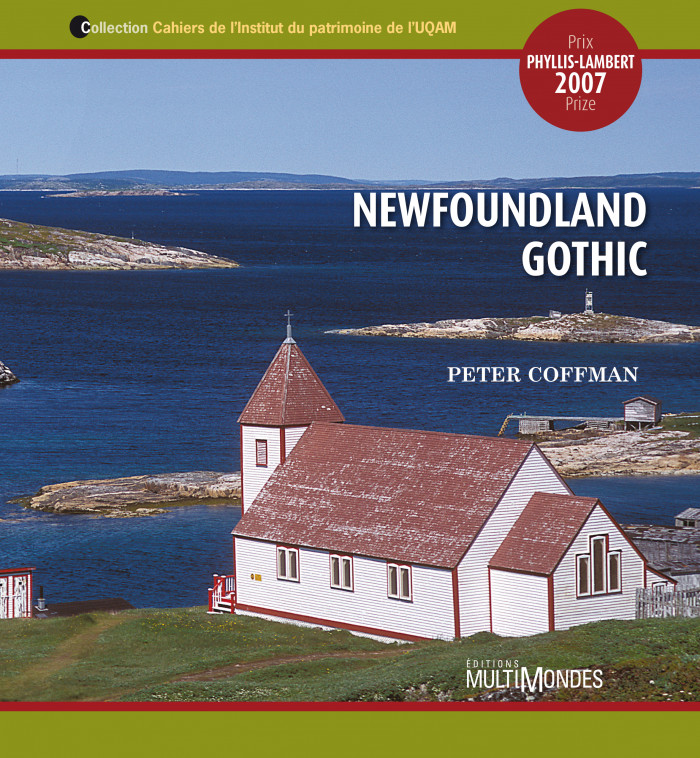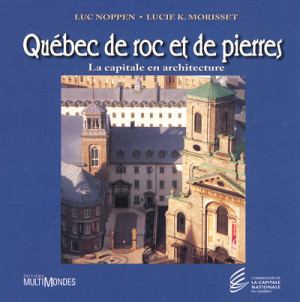How did an architectural style synonymous with medieval Europe become the style of choice in remote towns and outports of nineteenth-century Newfoundland and Labrador? From the city of St. John’s to isolated, wind-swept colonies like Battle Harbour, Labrador (cover), the Gothic style left an indelible mark on this unique and dramatic landscape. Newfoundland Gothic explores how and why the style came to the colony, the many forms it took, and what it meant to the people who used it.
Gothic Revival architecture came to Newfoundland and Labrador at a time when architectural style was laden with social meaning. The style arrived on the shores of British North America through the Established (Anglican) Church, and for that Church, the colonies were a torrid battleground. The enemies were heathenism, Romanism, and decadence; one of the key weapons in the fight was architecture, and the shape of that weapon was “Pointed,” or Gothic.
Copiously illustrated with original colour photographs showing many previously unpublished monuments, Newfoundland Gothic reveals a fascinating and unique chapter in the history of Canadian architecture and the history of architecture in the British Empire.
Le prix Phyllis-Lambert Prize
Chaque année, l’Institut du patrimoine de l’UQAM décerne le Prix Phyllis-Lambert à un(e) candidat(e) qui a soumis la meilleure thèse de doctorat ou le meilleur mémoire de maîtrise portant sur l’étude et l’histoire de l’architecture au Canada, selon l’évaluation qui en est faite par un jury indépendant.
Le prix honore Phyllis Lambert, architecte et figure tutélaire de la conservation architecturale, fondatrice du Centre Canadien d’Architecture, institution montréalaise mondialement reconnue pour son engagement dans la lutte pour la qualité du paysage construit.
Chaque année, au plus tard à la fin du mois de janvier, l’Institut du patrimoine de l’UQAM lance un appel au sein de la communauté des historiens d’architecture et des architectes du Canada pour que soient soumis les thèses ou mémoires ayant pour thème l’histoire de l’architecture au Canada (histoire, théorie, critique et conservation) et complétés dans les deux années précédentes. Les documents soumis sont évalués par un jury national dont l’Institut du patrimoine de l’UQAM nomme les membres.
Le Prix Phyllis-Lambert consiste en un certificat de reconnaissance accompagné d’une bourse de 1500$, versée par la Fondation de l’UQAM. L’Institut du patrimoine offre par ailleurs une aide à la publication du texte récompensé, dans l’une de ses collections ou chez un éditeur indépendant et porte en couverture la mention «Prix Phyllis-Lambert». Le prix est remis lors d’une activité spéciale, inscrite dans le programme du congrès annuel de la Société pour l’étude de l’architecture au Canada (SÉAC) qui se tient en alternance dans différentes villes du Canada.
Phyllis-Lambert Prize
Each year, the Phyllis Lambert Prize is awarded by UQAM’s Institut du patrimoine to a candidate who has submitted the best doctoral dissertation or best master’s thesis on the subject of architecture and architectural history in Canada, based on the assessment of an independent jury.
This prize honours Phyllis Lambert, architect and tutelary figure of architectural conservation, founder of the Canadian Centre for Architecture, a Montreal institution renowned worldwide for its involvement in the promotion of the quality of the built environment.
Each year, at the latest by the end of January, UQAM’s Institut du patrimoine asks the community of Canadian architectural historians and architects for the submission of dissertations and theses dealing with Canadian architectural history (history, theory, critics, and conservation) that have been completed during the two previous years. The documents submitted are evaluated by a national jury whose members are appointed by UQAM’s Institut du patrimoine.
The Phyllis Lambert Prize consists of a certificate of recognition that comes with a $1500 scholarship, awarded by the Fondation UQAM. In addition, the Institut du patrimoine offers assistance for the publication of the prize-winning text, either in one of its collections or with an independent publisher. The cover page of the publication bears the mention “Phyllis-Lambert Prize”. The prize will be awarded during a special ceremony included in the program of the annual conference of the Society for the Study of Architecture in Canada (SSAC) – held in turn in various cities throughout Canada.
La collection Cahiers de l’Institut du patrimoine de l’UQAM
Collection dirigée par Luc Noppen
Dans le monde entier, le patrimoine, les constructions et les représentations patrimoniales occupent aujourd’hui une place de choix dans la recherche universitaire.
Les Cahiers de l’Institut du patrimoine de l’UQAM font écho, depuis Montréal, aux questionnements et aux explorations que ce vaste domaine soulève, dans le but de mieux comprendre les mécanismes qui engendrent les ancrages identitaires et qui pavent la voie aux constructions mémorielles.
Études et analyses sur les objets, les traces, les usages, les savoir-faire, mais aussi sur les représentations et sur les mémoires concourent ici à une définition élargie de la notion de patrimoine qui échappe aux cloisonnements disciplinaires; le patrimoine apparaît ici comme outil sociétal de projection dans l’avenir plutôt que comme l’encensoir d’un passé glorifié.
L’Institut du patrimoine de l’UQAM offre cette collection aux recherches de la relève, autant celle qui évolue dans ses murs que celles qui, ailleurs dans le monde, se consacrent à cette réinvention du patrimoine. Au fil des projets et des propositions, les titres des Cahiers baliseront les travaux en cours et un réseau d’échanges et de collaborations, anciennes ou nouvelles.
How did an architectural style synonymous with medieval Europe become the style of choice in remote towns and outports of nineteenth-century Newfoundland and Labrador? From the city of St. John’s to isolated, wind-swept colonies like Battle Harbour, Labrador (cover), the Gothic style left an indelible mark on this unique and dramatic landscape. Newfoundland Gothic explores how and why the style came to the colony, the many forms it took, and what it meant to the people who used it.
Gothic Revival architecture came to Newfoundland and Labrador at a time when architectural style was laden with social meaning. The style arrived on the shores of British North America through the Established (Anglican) Church, and for that Church, the colonies were a torrid battleground. The enemies were heathenism, Romanism, and decadence; one of the key weapons in the fight was architecture, and the shape of that weapon was “Pointed,” or Gothic.
Copiously illustrated with original colour photographs showing many previously unpublished monuments, Newfoundland Gothic reveals a fascinating and unique chapter in the history of Canadian architecture and the history of architecture in the British Empire.
Le prix Phyllis-Lambert Prize
Chaque année, l’Institut du patrimoine de l’UQAM décerne le Prix Phyllis-Lambert à un(e) candidat(e) qui a soumis la meilleure thèse de doctorat ou le meilleur mémoire de maîtrise portant sur l’étude et l’histoire de l’architecture au Canada, selon l’évaluation qui en est faite par un jury indépendant.
Le prix honore Phyllis Lambert, architecte et figure tutélaire de la conservation architecturale, fondatrice du Centre Canadien d’Architecture, institution montréalaise mondialement reconnue pour son engagement dans la lutte pour la qualité du paysage construit.
Chaque année, au plus tard à la fin du mois de janvier, l’Institut du patrimoine de l’UQAM lance un appel au sein de la communauté des historiens d’architecture et des architectes du Canada pour que soient soumis les thèses ou mémoires ayant pour thème l’histoire de l’architecture au Canada (histoire, théorie, critique et conservation) et complétés dans les deux années précédentes. Les documents soumis sont évalués par un jury national dont l’Institut du patrimoine de l’UQAM nomme les membres.
Le Prix Phyllis-Lambert consiste en un certificat de reconnaissance accompagné d’une bourse de 1500$, versée par la Fondation de l’UQAM. L’Institut du patrimoine offre par ailleurs une aide à la publication du texte récompensé, dans l’une de ses collections ou chez un éditeur indépendant et porte en couverture la mention «Prix Phyllis-Lambert». Le prix est remis lors d’une activité spéciale, inscrite dans le programme du congrès annuel de la Société pour l’étude de l’architecture au Canada (SÉAC) qui se tient en alternance dans différentes villes du Canada.
Phyllis-Lambert Prize
Each year, the Phyllis Lambert Prize is awarded by UQAM’s Institut du patrimoine to a candidate who has submitted the best doctoral dissertation or best master’s thesis on the subject of architecture and architectural history in Canada, based on the assessment of an independent jury.
This prize honours Phyllis Lambert, architect and tutelary figure of architectural conservation, founder of the Canadian Centre for Architecture, a Montreal institution renowned worldwide for its involvement in the promotion of the quality of the built environment.
Each year, at the latest by the end of January, UQAM’s Institut du patrimoine asks the community of Canadian architectural historians and architects for the submission of dissertations and theses dealing with Canadian architectural history (history, theory, critics, and conservation) that have been completed during the two previous years. The documents submitted are evaluated by a national jury whose members are appointed by UQAM’s Institut du patrimoine.
The Phyllis Lambert Prize consists of a certificate of recognition that comes with a $1500 scholarship, awarded by the Fondation UQAM. In addition, the Institut du patrimoine offers assistance for the publication of the prize-winning text, either in one of its collections or with an independent publisher. The cover page of the publication bears the mention “Phyllis-Lambert Prize”. The prize will be awarded during a special ceremony included in the program of the annual conference of the Society for the Study of Architecture in Canada (SSAC) – held in turn in various cities throughout Canada.
La collection Cahiers de l’Institut du patrimoine de l’UQAM
Collection dirigée par Luc Noppen
Dans le monde entier, le patrimoine, les constructions et les représentations patrimoniales occupent aujourd’hui une place de choix dans la recherche universitaire.
Les Cahiers de l’Institut du patrimoine de l’UQAM font écho, depuis Montréal, aux questionnements et aux explorations que ce vaste domaine soulève, dans le but de mieux comprendre les mécanismes qui engendrent les ancrages identitaires et qui pavent la voie aux constructions mémorielles.
Études et analyses sur les objets, les traces, les usages, les savoir-faire, mais aussi sur les représentations et sur les mémoires concourent ici à une définition élargie de la notion de patrimoine qui échappe aux cloisonnements disciplinaires; le patrimoine apparaît ici comme outil sociétal de projection dans l’avenir plutôt que comme l’encensoir d’un passé glorifié.
L’Institut du patrimoine de l’UQAM offre cette collection aux recherches de la relève, autant celle qui évolue dans ses murs que celles qui, ailleurs dans le monde, se consacrent à cette réinvention du patrimoine. Au fil des projets et des propositions, les titres des Cahiers baliseront les travaux en cours et un réseau d’échanges et de collaborations, anciennes ou nouvelles.
Afficher
Lauréat
Bourse Phyllis-Lambert 2007




